Heno-heno 変じゃないのぉ?? What’s all this heno-heno business then? We take a brief look at this classic idea known by all Japanese people.
Heno-heno-moheji is basically a children’s character. But why the strange, long name? It’s a clever play on the hiragana alphabet, which makes it great for beginning learners to spice up their studies with. It’s incredibly simple really, and you should be able to figure it out with just the image below. Did you get it yet?
It’s a cup I recently bought from the 100 yen store with a silly face on. Still in that lovely Japanese calligraphic style too! What’s strange about this face is how it is constructed. Can you see the symbols?
への への もへ じ
The two eyebrows are made up of the hiragana character へ (he). The two eyes, they are the character の (no). The nose is も (mo), the mouth another へ (he) and finally a large じ (ji) to circle the face. Pretty cool, no?
That makes us the Heno-heno-moheji character! You’ll can often find this face being used in children’s cartoons and learning materials, as well as on the ubiquitous かかし (scarecrows) out in the Japanese rice fields.

You might also spot then on the dolls called てるてる坊主 (てるてるぼうず) that are hung up to prevent rain the next day. The name literally means ‘shiny shiny Buddhist monk’, and quite resembles one too, with the bald head. Legend has it that if you hang one upside down, it will reverse the effect and cause it to rain the next day.

Have you seen てるてる坊主 or へのへのもへじ before? Where did you come across them?

Leave a Reply